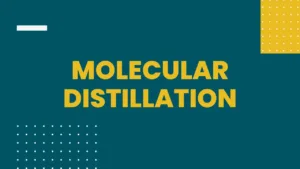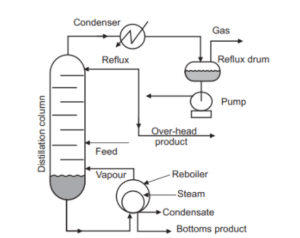Molecular Distillation

Molecular Distillation
Definition
• It is a distillation process in which each molecule in the vapour phase travels mean free path and gets condensed individually without inter-molecular collisions on application of vacuum
• Molecular distillation is based on the principle of the simple distillation with some modifications
• This is also called evaporation distillation or short path distillation
Principle of Evaporation Distillation/Molecular Distillation
• The substances to be distilled have very low vapour pressures. Examples are viscous liquids, oils, greases, waxy materials and high molecular weight substances. These boil at very high temperature.
• In order to decrease the boiling point of the liquids, high vacuum must be applied
• The vapour pressure above the liquid is much lower.
• At very low pressure, the distance between the evaporating surface and the condenser is approximately equal to the mean free path of the vapour molecules
• Molecules leaving the surface of the liquid are more likely hit the condenser surface nearby. Each molecule is condensed individually
• The distillate is subsequently collected

Theory
The mean free path of a molecule is defined as the average distance through which a molecule can move without coming into collision with another
The mean path (λ.) can be expressed mathematically as:
λ = η v 3
p.ρ
where. p = vapour pressure, kPa
p = density, kg/m3
η = viscosity, Pa’s
λ = mean path length, m
For example, mean path (heavy molecules) of butyl phthalate is about 30 mm and of olive oil is 20 mm when measured at a pressure of 0.1 pascal
The mean free path can be increased by decreasing the viscosity which can be obtained at high temperature and low pressure
Thus, nonvolatile substances may become volatile and distillation is possible
Requirements for design the equipment
• The evaporating surface must be close to the condensing surface.
This ensures the molecules to come in contact with the condenser as soon as they leave the evaporating surface
For this reason, this process is also known as short path distillation
• The molecular collisions should be minimized because they change the direction of the path of molecules
• In other words, intermolecular distances should be fairly high.
• It can be achieved under very high vacuum, usually of the order of 0.1 to 1.0 pascals
• The liquid surface area must be as large as possible as so that the vapour is evolved from the surface only, but not by boiling.
• Thus this process is also called evaporation distillation
Advantages of Molecular Distillation
1. High Purity Levels:
- One of the primary advantages of molecular distillation is its ability to achieve exceptionally high purity levels. The process effectively separates components based on their molecular weights, resulting in purified substances.
2. Low Thermal Degradation:
- Molecular distillation operates under high vacuum conditions, minimizing the risk of thermal degradation. This is particularly beneficial for heat-sensitive compounds that might be compromised in traditional distillation methods.
3. Versatility in Applications:
- Molecular distillation finds applications in various industries, including pharmaceuticals, food, and essential oil production. Its versatility makes it a valuable asset for different processes requiring precision and purity.
4. Energy Efficiency:
- Compared to some conventional distillation methods, molecular distillation is energy-efficient. The reduced energy consumption aligns with modern sustainability goals and contributes to a smaller carbon footprint.
5. Reduced Environmental Impact:
- The minimal waste generated during molecular distillation contributes to a reduced environmental impact. This aligns with the growing emphasis on sustainable and eco-friendly industrial practices.
6. Customization and Control:
- Molecular distillation allows for precise control over the separation process. This level of customization is advantageous for industries where specific product characteristics are paramount.
Disadvantages of Molecular Distillation
1. Complexity and Cost:
- Implementing molecular distillation can be complex and requires specialized equipment. The initial investment and operational costs can be higher compared to some traditional distillation methods, posing a challenge for smaller businesses.
2. Scalability Issues:
- Scaling up molecular distillation processes can be challenging. Achieving consistent results on a larger scale may require additional considerations and adjustments, impacting overall efficiency.
3. Maintenance Challenges:
- The sophisticated nature of molecular distillation equipment may lead to maintenance challenges. Regular upkeep and skilled personnel are essential to ensure the longevity and optimal performance of the distillation system.
4. Limited to Certain Substances:
- Molecular distillation is more effective for certain types of substances, and its applicability may be limited in some cases. It may not be the ideal choice for all types of compounds or mixtures.
5. Potential for Cross-Contamination:
- In certain scenarios, there is a potential risk of cross-contamination during molecular distillation. Proper cleaning procedures and equipment design are crucial to mitigate this risk effectively.
6. Learning Curve:
- Operators and technicians need specialized knowledge to operate and maintain molecular distillation systems. The learning curve may pose a challenge for industries transitioning from traditional distillation methods.
FAQs About Molecular Distillation
- Is molecular distillation only applicable to liquid substances?
- Molecular distillation is commonly used for liquids but can also be adapted for certain solid substances under specific conditions.
- What industries benefit the most from molecular distillation?
- Pharmaceutical, food, and essential oil industries are among the primary beneficiaries of molecular distillation.
- How does molecular distillation contribute to environmental sustainability?
- Molecular distillation is energy-efficient, reducing carbon emissions, and generates minimal waste, aligning with sustainability goals.
- Are there any safety concerns associated with molecular distillation?
- Adherence to safety protocols is crucial, and modern equipment is designed with safety features to minimize risks.
- What is the future potential of molecular distillation technology?
- The future holds promise for even more advanced technologies, further enhancing the efficiency and applicability of molecular distillation.
- Can molecular distillation be used for all types of compounds?
- Molecular distillation is more effective for certain types of compounds, and its applicability may be limited in some cases.
- Is the initial cost of implementing molecular distillation justified by its benefits?
- The decision depends on the specific needs and capabilities of the industry. While molecular distillation offers advantages, the initial investment should be weighed against the benefits.
- What measures can be taken to mitigate the risk of cross-contamination in molecular distillation?
- Proper cleaning procedures and equipment design are crucial to mitigate the risk of cross-contamination during the process. Regular maintenance and adherence to safety protocols are essential.
Also, Visit:
B. Pharma Notes | B. Pharma Notes | Study material Bachelor of Pharmacy pdf